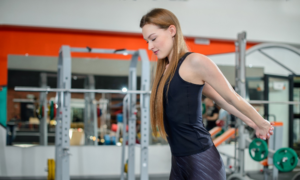Body aches are often caused by poor posture or improper muscle use. Sleep takes up about one-third of our day, and sleeping in the wrong position can lead to lower back pain and poor sleep quality. Pan Jiahao, a physical therapist at Jing-Her Chinese Medicine Clinic in Taiwan, shares two lower back stretches that can help improve sleep quality.
The Most Harmful Sleeping Position
Of the three sleeping positions—on your back, side, or stomach—side sleeping is the most harmful, according to Pan. The excessive twisting of the cervical spine and shoulders in this position can, over time, lead to cervical disc herniation, causing symptoms like headaches, neck pain, and numbness or tingling in the arms and hands.
Sleeping on your stomach is also not ideal, as it forces the neck into a twisted position, creating uneven pressure on the cervical spine and potentially leading to discomfort.
However, this is not a one-size-fits-all recommendation. For people with lower back pain, sleeping on the back or stomach may be more suitable, as these positions do not strain the lower back. Similarly, for people with neck and shoulder issues, or those recovering from minor back surgery, sleeping on the side may be a better option.
Pan recommends that side sleepers place a pillow between their thighs. When the legs are pressed together in the side-sleeping position, the knees touch, which forces the hip joints to rotate inward and puts extra pressure on the hips. Additionally, resting against the headboard with a pillow or cushion to look at your phone before bed, or lying on the couch with your head propped on the armrest—especially when the neck is bent at more than a 45-degree angle—are poor postures that can lead to neck and shoulder pain, and even disc compression. Therefore, lying on your back remains the best sleeping position for spinal health.
However, some people simply do not prefer sleeping on their back. The inability to lie flat often suggests tightness in the shoulder and back muscles, Pan explained. When these muscles are tense, the neck may feel unsupported, and the lower back can arch, preventing proper alignment with the mattress and making it hard to fully relax. As a result, many opt for side sleeping to alleviate the pressure. Therefore, relaxing the tense neck and back muscles is crucial. Pan recommends two lower back stretches to help release tension in these muscles.

Iliopsoas Muscle Stretch. (The Epoch Times)
Exercise 1: Iliopsoas Muscle Stretch
Prolonged sitting due to modern work routines restricts movement in the iliopsoas muscle, which connects the lower back and hips, leading to tightness. Over time, this can cause anterior pelvic tilt, further contributing to lower back discomfort. Relaxing the iliopsoas muscle is the first step in relieving neural tension in the lower back.
Steps:
- Lie on your back and extend your right leg. Using your hip strength, lift your straightened right leg to its highest point, then lower it slightly.
- Keep your right leg straight and slowly alternate between flexing and pointing your toes (dorsiflexion and plantarflexion), repeating this movement two to three times.
- Keep your right leg straight and slowly lower it in a controlled manner. This movement helps strengthen the iliopsoas muscle. Once your ankle touches the ground, relax. Repeat the same movement with your left leg.
This stretch incorporates neural mobilization techniques, Pan noted. Arching of the lower back when lying down may be due to pressure on the discs or pinched nerves in the legs. Straightening the knee and alternating between flexing and pointing the foot stretches the tight nerves and muscles, helping to relieve neural tension. This, in turn, helps release tension in the soft tissues and alleviate stiffness in the lower back and legs.

Dead Bug Variation. (The Epoch Times)
Exercise 2: Dead Bug Variation
This stretching exercise aims to strengthen the muscles in the obliques, hips, and pelvis.
Steps:
- Lie on your back with both legs bent. Position your thighs at a 90-degree angle to your torso and your knees at a 90-degree angle to your calves. Keep your legs parallel, without bringing them together or spreading them too far apart.
- While maintaining the 90-degree bend in your knees, slowly lower your right leg until your foot touches the ground, then relax. For a more advanced variation, lift your leg back up immediately after it touches the ground. Repeat the same movement with your left leg.
- With your knees still bent at 90 degrees, slowly rotate both knees to the right, keeping them parallel and ensuring your lower back stays flat. Once you reach your limit, return to the starting position. Repeat the movement to the left.
If you experience difficulty when lowering your knee to a certain point during the exercises mentioned above, it suggests a lack of muscle strength at that angle. Pan recommends performing two sets of each exercise daily, with 10 repetitions per leg in each set, to help improve sleep quality.















